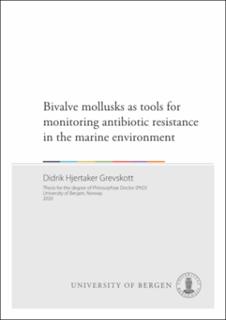| dc.contributor.author | Grevskott, Didrik Hjertaker | |
| dc.date.accessioned | 2020-04-23T09:22:38Z | |
| dc.date.available | 2020-04-23T09:22:38Z | |
| dc.date.issued | 2020-04-29 | |
| dc.date.submitted | 2020-04-09T07:33:09.209Z | |
| dc.identifier | container/09/3a/fb/f1/093afbf1-9ffa-45ee-81e6-08734da9384c | |
| dc.identifier.uri | http://hdl.handle.net/1956/21984 | |
| dc.description.abstract | Antibiotic resistance (AR) is a major global health concern, especially in clinical and veterinary settings. Environmental niches, including the aquatic environment, serve as a source of and/or a dissemination route for antibiotic resistance genes (ARGs) and resistant bacteria. Bivalves are suspension feeders that actively filter, retain and concentrates particles from their surrounding water, including free living or particle-bound bacteria. The main aim of this thesis was to evaluate bivalve mollusks as tools for monitoring Escherichia coli and associated AR, in the marine environment in Norway. Sampling of bivalves were conducted from several sites along the Norwegian coast and the samples were examined for the presence of E. coli, according to the most probable number (MPN) EU reference method. More than half (61%) of the samples were positive for E. coli, and a selection of 200 E. coli isolates were further identified by matrix assisted laser desorption ionization-time of flight mass spectrometry (MALDI-TOF MS). The majority (90%) were confirmed as E. coli, while the remaining isolates (10%) were identified as other species mostly belonging to the Enterobacteriaceae family. The isolates were antibiotic susceptibility tested (AST) using the disk diffusion method recommended by the European Committee on Antimicrobial Susceptibility Testing (EUCAST). Seventy-five bacterial isolates (38%) showed phenotypic resistance to at least one antibiotic, while multidrug-resistance was observed in eight isolates (4%). Based on resistance phenotypes, selected E. coli isolates were subjected to whole-genome sequencing (WGS). Two isolates revealed to carry CTX-M-type extended-spectrum β-lactamases (ESBLs). Accordingly, the two E. coli isolates were subjected to long-read sequencing, and a hybrid de novo assembly using long-reads and short-reads to obtain complete and closed genome sequences. One isolate harbored four identical chromosomal copies of the blaCTX-M-14 gene, while the other isolate carried the blaCTX-M-15 gene on a conjugative plasmid. Another aim of this thesis was to generate knowledge regarding the prevalence of antibiotic and heavy metal resistance, and associated resistance genes, among environmental bacteria isolated from marine bivalves. Bivalves were collected from multiple sites along the Norwegian coast and the samples were subjected to quantitative and qualitative examinations. Quantitative examination involved growth of environmental bacteria on agar with and without antibiotics, while qualitative examination involved selective growth of bacteria in broths with antibiotics. A total of 205 bacterial isolates were identified by MALDI-TOF MS. Most of the bacterial species belonged to the genera Pseudomonas (36%) and Vibrio (11%). The bacterial isolates were AST by applying the EUCAST disk diffusion method. Accordingly, majority of the isolates revealed to be intrinsic resistant to a wide range of the antibiotics tested for. In addition, phenotypic susceptibility to the heavy metals copper, zinc and cadmium were examined by determining the minimum inhibitory concentration. Selected isolates were subjected to WGS. Among the isolates, clinically relevant ARGs, such as qnrVC, aph(3’) and catB, were detected. Moreover, several heavy metal resistance genes, including copA and copB, were present. Overall, the results presented in this thesis suggests that bivalves represent an important tool for the monitoring of clinically relevant ARGs and pathogens in the marine environment, especially in a low prevalence setting like Norway. It also strengthens the notion that the marine environment contributes to the dissemination of clinically important ARGs and pathogens. | en_US |
| dc.language.iso | eng | eng |
| dc.publisher | The University of Bergen | en_US |
| dc.relation.haspart | Paper I: Grevskott, D.H., Svanevik, C.S., Wester, A.L., Lunestad, B.T. 2016. The species accuracy of the Most Probable Number (MPN) European Union reference method for enumeration of Escherichia coli in marine bivalves. Journal of Microbiological Methods 131: 73-77. The article is available in the main thesis. The article is also available at: <a href="https://doi.org/10.1016/j.mimet.2016.10.006" target="blank">https://doi.org/10.1016/j.mimet.2016.10.006</a> | en_US |
| dc.relation.haspart | Paper II: Grevskott, D.H., Svanevik, C.S., Sunde, M., Wester, A.L., Lunestad, B.T. 2017. Marine bivalve mollusks as possible indicators of multidrug-resistant Escherichia coli and other species of the Enterobacteriaceae family. Frontiers in Microbiology 8(24): 1-10. The article is available in the main thesis. The article is also available at: <a href="https://doi.org/10.3389/fmicb.2017.00024" target="blank">https://doi.org/10.3389/fmicb.2017.00024</a> | en_US |
| dc.relation.haspart | Paper III: Grevskott, D.H., Francisco, S.-S., Moore, E.R.B., Marathe, N.P. 20XX. Nanopore sequencing reveals genomic map of CTX-M-type extended-spectrum β- lactamases carried by Escherichia coli strains isolated from blue mussels (Mytilus edulis) in Norway. The article is not available in BORA. | en_US |
| dc.relation.haspart | Paper IV: Svanevik, C.S., Grevskott, D.H., Storesund, J.E., Bernssen, L.S., Marathe, N.P., Lunestad, B.T. 20XX. Antimicrobial and heavy metal resistance among environmental bacteria isolated from marine bivalves along the Norwegian coast. The article is not available in BORA. | en_US |
| dc.rights | In copyright | eng |
| dc.rights.uri | http://rightsstatements.org/page/InC/1.0/ | eng |
| dc.title | Bivalve mollusks as tools for monitoring antibiotic resistance in the marine environment | en_US |
| dc.type | Doctoral thesis | |
| dc.date.updated | 2020-04-09T07:33:09.209Z | |
| dc.rights.holder | Copyright the Author. All rights reserved | en_US |
| fs.unitcode | 12-60-0 | |
